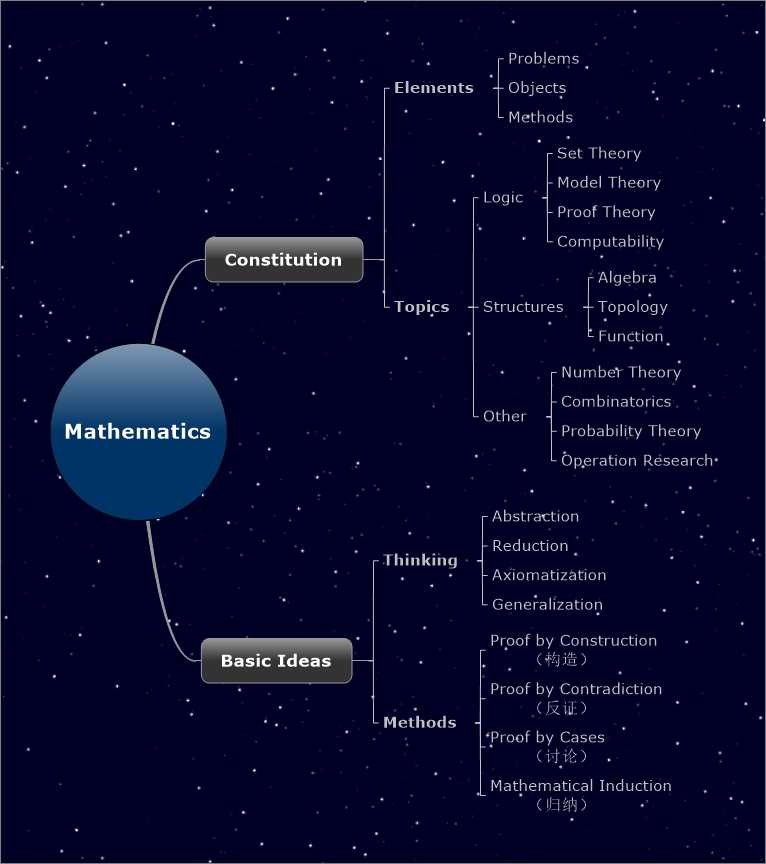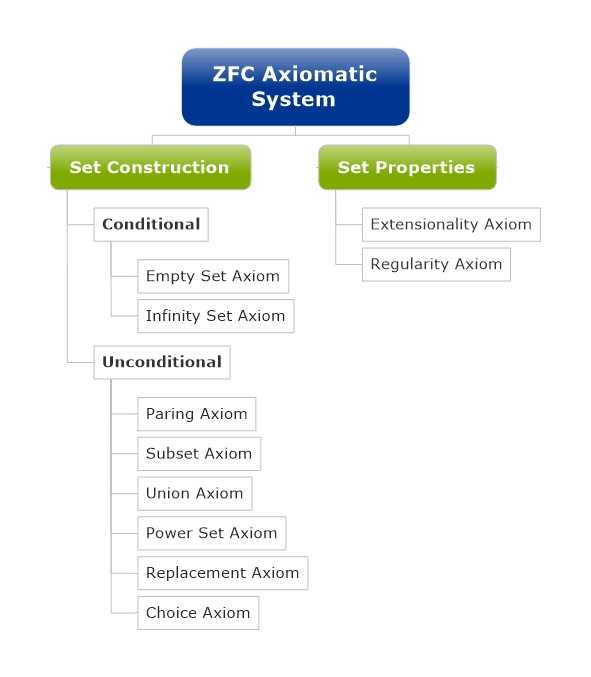标签:
1. An Overview of Mathematics
What do we talk about when we talk about Mathematics? Does it necessarily correlate to quantities, structures or spaces?
In my perspective, mathematics is a discipline that sheds light on thinking methods which can be tapped to myriad disciplines in natural science, even though mathematics itself is strikingly different from physics, chemistry or any other areas of natural science. Mathematics appears more like a bag of inventions than a collection of discoveries, which are usually made in laboratories by physicists or chemists. As a matter of fact, modern mathematics is based on a handful of axioms rather than observations in any experiments. However, mathematics constitutes the very foundation of natural science since it provides necessary thinking tools for the development of all other subjects.
As far as I know, mathematics contains far more topics than what we have learned in class or from any textbooks. Here I shall provide a big piture of mathematics in my comprehension:

As a computer science major, I feel obliged to master some basic mathematical knowledge since what we call computer science was exactly derived from mathematics dating back to the times of Alan Turing. Mathematics is the supporting pillar of the so-called Computation Theory, which includes Formal Language, Computability Theory and Computation Complexity Theory, and it is largely based on mathematical logic. Moreover, we should drink deep in mathematics since mathematis itself is more than captivating by virtue of its beauty of rigidity and the challenges of thorny problems. That‘s exactly the reason why I was entirely gripped by the book Sureal Numbers last summer even though I was having an awful fever at that time.
2. ZFC Axiomatic System
ZFC is short for Zermelo-Fraenkel Set Theory with Choice Axiom, which is the most common foundation of modern mathematics. It includes the following axioms:
(1) Extensionality Axiom: two sets are equal if they have exactly the same members
(2) Regularity Axiom: every nonempty set A has a member m with m ∩ A = ∅
(3) Empty Set Axiom: there exists a set containing no members
(4) Infinity Set Axiom: there exists an inductive set A i.e. (∃A) [∅ ∈ A ∧ (∀a ∈ A) a+ ∈ A]
(5) Paring Axiom: for any sets u and v, there is a set containing exactly u and v
(6) Subset Axiom: (∀x)(∃y)(∀z) (z∈y ↔ (z∈x)∧P(z)), where P(z) is a predicate logic
(7) Union Axiom: for any set A, there exists a set B whose elements are exactly the members of the members of A
(8) Power Set Axiom: for any set A, there is a set whose members are exactly the subsets of A
(9) Replacement Axiom: for any formula α(x,y) not containing the letter B, the following is an axiom
(∀A)[(∀x∈A)(∀y1)(∀y2)(α(x, y1)∧α(x, y2) → y1 = y2) → (∃B)(∀y)((y∈ B) ↔(∃x∈A)α(x, y))]
(10) Choice Axiom: for any relation R, there exists a function F such that F ⊆ R, and Dom(R)=Dom(F)

3. Set Operations
In an axiomatic system, a new notion can be introduced in either the Axiomatic Appoach or the Constructive Approach. Though I will omit the rigid proofs, all the notions I list below are constructed based on the axioms in ZFC system.
(1) Union, Intersection and Complement: please see Boolean Algebra
(2) Power Set: x ∈ P(A) iff x ⊆ A
then we have: P(A) ⊆ P(B) ⇔ A ⊆ B P(A) ∈ P(B) ⇒ A ∈ B P(A) ∩ P(B) = P(A ∩ B) P(A) ∪ P(B) ⊆ P(A ∪ B)
(3) Arbitrary Union/Intersection: x ∈∪A iff (∃a)(x∈a ∧ a∈A) x ∈∩A iff (∀a)(a∈A → x∈a)
then we have: ∅ ≠ A ⊆ B ⇒ ∩B ⊆ ∩A A ⊆ B ⇒ ∪A ⊆ ∪B
(4) Kuratowski‘s Construction of Ordered Pair: <x, y> = {{x}, {x,y}}
for n-ary tuple: <x1,...,xn> = <<<x1,...,xn-1>, xn> (n>2)
(5) Cartesian Product: a collection of ordered pairs (n-ary tuples) on the given sets
(6) Relation: a subset of Cartesian Product on the given sets
(7) Function: a special relation such that for every x∈ D, there exists exactly one y∈ R such that y = f(x)
4. Natural Number Set
The key idea of ZFC Axiomatic System is that everything is a set and the entire mathematics can be embedded in Set Theory.
To construct the natural number set, we should first define the Successor of a set: a+ = a ∩ {a}. And then we introduce the concept of Inductive Set: a set A is inductive iff ∅∈ A and A is closed under successor. According to Infinity Axiom, there must exist some inductive sets, and thus we can define the natural number set ?? as a set belongs to every inductive set in light of Subset Axiom.
One may easily find that ?? is an inductive set itself and has a property as follow: any inductive subset of ω coincides with ω. This is a useful principle, which constitutes the foundation of Mathematical Induction. Moreover, ?? is also a transitive set and every natural number is a transitive set, which indicates it is a Peano System. Now, we can define the ordering on ?? and prove the transitivity, trichotomy and well ordering principle respectively. Once we have proved the well ordering principle, the Strong Induction on ?? is valid now.
Besides Induction Principle, another thing we should mention is Recursion Theorem on ??: given a∈ A and F:A→A, there exists a unique function h: ω →A such that h(0)=a and h(n+)=F(h(n)) (I can recall that the proof of this theorem was far beyond my grasp when I read it for the first time). Based on this principle, arithmetic operations such as addition, multiplication and exponentiation can be well defined, and we can derive their numerous properties as well.
From natural number set, we can construct Integer Set, Rational Number Set and Real Number Set step by step, and embed all of them into Set Theory.
5. Cardinal Numbers
To begin with, we define a set A is equinumerous to a set B iff there is a bijection from A to B. We can find that equinumerousity is an equivalent relation since it satisfies reflexivity, symmetry and transitivity. By proper construction, we can prove that the natural number set is equinumerous to the odd/even number set, the integer set, and even the rational number set. However, Cantor‘s Diagonal Method can lend support to the fact that a set can never be equinumerous to its power set, which indicates that the real number set cannot be equinumerous to the natural number set. We define that a set is finite if it is equinumerous to some natural number, and then the Pigeonhole Principle comes into being: no finite set is equinumerous to its proper subset. With a further exploration, you can prove that a set is infinite if and only if it has a proper subset that is equinumerous to itself.
Now we would invite the notion Cardinal Number of a set such that Card(A)=Card(B) iff A and B are equinumerous. For a finite set, the cardinal number can be defined as the natural number that is equinumerous to it. As regards infinite sets, you can refer to the Ordinal Number of a well-ordering set. We can define the arithmetic operations on cardinal numbers according to the set operations. Also, we can define the ordering of cardinal numbers based on the concept domination: a set A is dominated by a set B iff there exists an injection from A to B. Domination is a partial order since it satisfies reflexivity and transitivity. A strong conclusion about domination is Schröder-Bernstein Theorem, which states that two sets are equinumerous if they are dominated by each other. (The proof of this theorem is one of the most tricky constructions that I‘ve ever seen.) Another property of domination is an equivalent statement of Choice Axiom: for any two sets A and B, either A is dominated by B or B is dominated by A.
A set is countable iff it is dominated by the natural number set. A set is denumerable iff it is equinumerous to the natural number set, and a countable set is either finite or denumerable. This is based on the fact that the natural number set is dominated by any other infinite sets. There is a Continuum Hypothesis that the next smallest cardinal number should be the cardinal number of the real number. However, as Kurt Gödel argued, this hypothesis can never be proved or belied in the ZFC Axiomatic System.
References:
1. Herbert B. Enderton. Elements of Set Theory [M]. 北京:人民邮电出版社. 2006-04
Set Theory: the Foundation of Mathematics
标签:
原文地址:http://www.cnblogs.com/DevinZ/p/4409314.html